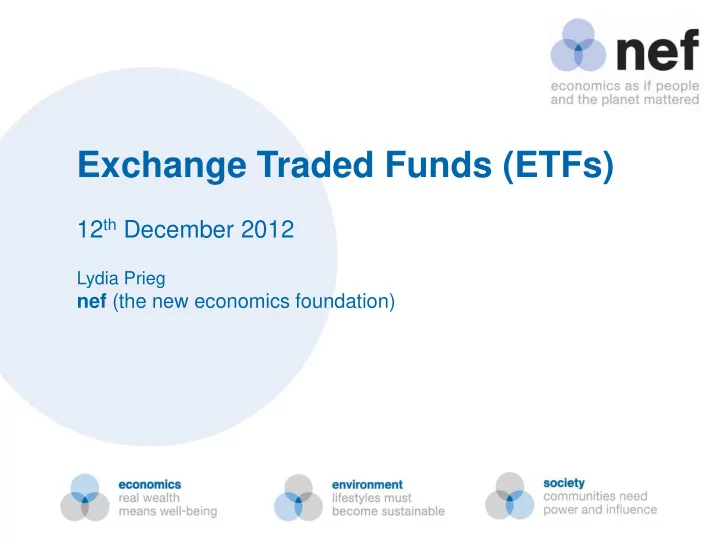

Exchange Traded Funds (ETFs) 12 th December 2012 Lydia Prieg nef (the new economics foundation)
Exchange Traded Funds (ETFs) • The basic concept • Physical ETFs • Synthetic ETFs • Actively Managed ETFs • Commodities ETFs • ETFs and systemic risk
ETFs: The Basic Rationale • First developed in Canada in 1990, before launching in the USA and Europe in 1993 and 2000, respectively. • Empirical studies concluding that mutual funds generally struggle to out-perform the market. • Originally ETFs just tracked equity markets, but in 2000 fixed income ETFs were introduced, followed by commodities ETFs in 2001. • AUM have increased 349% in a period of five years, to $1,839 bn in 2012. • ETFs have yet to rival mutual funds, as the former are currently only 6% of the size of the latter.
ETFs: What do they track?
Physical ETFs
Physical ETFs • Fees vary enormously, even for ETFs that track large, liquid indices. • Some funds make very large tracking errors. • How passive are they in illiquid markets? • ETFs that track illiquid markets are only liquid as long as market makers are prepared to provide liquidity. • Securities lending means they don’t qualify as Unit Investment Trusts in the US.
Synthetic ETFs
Synthetic ETFs • Daily resetting means that the performance of the fund will frequently differ from that of the advertised index it is tracking. • Increased end of day volatility due to resetting. • Many investors are unaware that their investment is dependent on the financial health of investment banks. • Collateral may have no relation to the market the ETF is tracking. • Securities lending may introduce additional risk.
Actively Managed ETFs • First launched in March 2008. • Higher management fees. • Tension between transparency and the market front- running trades. • Market makers won’t be able to arbitrage if they are unaware of the content of the actively managed fund. This could result in significant trading departures from a fund’s true net asset value. • Will these ETFs attract good fund managers? • Industry still in its infancy.
Synthetic Commodities ETFs • They track a commodity’s futures price, not the price of the physical commodity itself – this introduces roll yield. • The rolling process is often highly expensive, and can result in investors losing money, even when the price of the commodity itself has increased. • Pre-rolling can occur. • Dynamic rolling increases management costs. • What percentage of the public who have bought such ETFs understand ‘rolling’, and how it may impact on their investment?
Synthetic Commodities ETFs • Many researchers have attempted to investigate the effect of speculative investment on commodities prices empirically, but the findings, so far, have been mixed. • However, there is a mechanism by which speculation via futures can, in theory, impact on physical commodities prices. • Whilst speculation undoubtedly can bring valuable liquidity to a market and help smooth volatility, speculators now constitute the majority of participants in many commodities markets. • Precautionary principle.
Composition of the Chicago Wheat Futures Market
Physical Commodities ETFs • Avoid roll yield but incur expensive storage costs (especially for base metals). • Do they interfere with the underlying market? – The market is incentivising investors to store physical commodities, as prices reflect the fact that these resources are more needed in the future than in the present. – But what happens if investors are still buying units in physically backed ETFs when there is a near-term shortage in the market? – Could metals grow to be seen as a safe-haven amidst a ‘flight to quality’, or used as a hedge against inflation?
ETFs: Systemic Risk? • Regulators have already begun to issue warnings that investment banks may not be able to cope if investors pull out en-masse from an ETF. • ETFs also magnify the interconnectedness of investment banks with the rest of the financial system. • While investment in ETFs remains a small percentage of, for example, investment in traditional mutual funds, it is unlikely that the industry poses a large risk to the financial system. • If ETFs continue to grow at the rate seen in recent years, this may soon no longer be the case.
Summary • ETFs are no longer the simple, transparent products they once were. • Many should no longer be marketed to the general public. • Some are unlikely to make money for anyone other than their providers. • Doubts about how passive they really are. • Unlikely to currently be a source of systemic risk, but, if they continue to grow and the same rate they have done in recent years, they should be watched.
This presentation has been produced with the financial assistance of Aviva Investors and the European Union. The contents of this presentation are the sole responsibility of nef (the new economics foundation) and can under no circumstances be regarded as reflecting the position of Aviva Investors or the European Union .
Recommend
More recommend